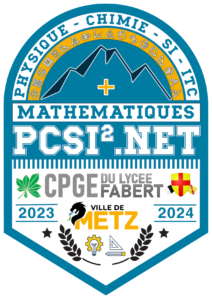
\(\newcommand{\eps}{\varepsilon}
\newcommand{\llbracket}{[\![}
\newcommand{\rrbracket}{]\!]}
\newcommand{\D}{\mathrm{D}}
\newcommand{\C}{\mathbb{C}}
\newcommand{\Q}{\mathbb{Q}}
\newcommand{\R}{\mathbb{R}}
\newcommand{\U}{\mathbb{U}}
\newcommand{\K}{\mathbb{K}}
\newcommand{\N}{\mathbb{N}}
\newcommand{\M}{\mathrm{M}}
\newcommand{\DL}{\mathrm{DL}}
\newcommand{\rg}{\mathrm{rg}\,}
\newcommand{\id}{\mathrm{id}}
\newcommand{\GL}{\mathrm{GL}}
\newcommand{\card}{\mathrm{Card}\,}
\newcommand{\Det}{\mathrm{Det}}
\newcommand{\union}{\cup}
\renewcommand{\Im}{\mathrm{Im}\,}
\renewcommand{\Re}{\mathrm{Re}\,}
\newcommand{\Ker}{\mathrm{Ker}\,}
\newcommand{\vect}{\mathrm{vect}}
\newcommand{\inter}{\cap}
\newcommand{\ch}{\mathrm{ch}\,}
\newcommand{\sh}{\mathrm{sh}\,}
\renewcommand{\th}{\mathrm{th}\,}
\newcommand{\argch}{\mathrm{argch}\,}
\newcommand{\argsh}{\mathrm{argsh}\,}
\newcommand{\argth}{\mathrm{argth}\,}
\newcommand{\Z}{\mathbb{Z}}
\newcommand{\mfrac}[2]{\genfrac{}{}{0pt}{}{#1}{#2}}
\newcommand{\cotan}{\mathrm{cotan}\,}
\newcommand{\tr}{\mathrm{Tr}\,}
\)
Savoir faire : Savoir vérifier si une partie d’un espace vectoriel est, ou non, un sous-espace vectoriel de cet espace.
Exercice :
Soit \(n \geqslant 2\). Parmi les ensembles suivants, lesquels sont des sous-espaces vectoriels de l’espace vectoriel \(\mathbb{R}^n\) ?
\[\begin{align*}&F_1=\left\{\left(x_1, \ldots, x_n\right) \in \mathbb{R}^n \,|\, x_1=0\right\}\\[10pt]& E_2=\left\{\left(x_1, \ldots, x_n\right) \in \mathbb{R}^n \,|\, x_1=1\right\}\\[10pt]
&E_3=\left\{\left(x_1, \ldots, x_n\right) \in \mathbb{R}^n \,|\, x_1^2+x_2^2=0\right\}\\[10pt]
&E_4=\left\{\left(x_1, \ldots, x_n\right) \in \mathbb{R}^n \,|\, x_1^2=x_2^2\right\}\\[8pt]
&E_5=\left\{\left(x_1, \ldots, x_n\right) \in \mathbb{R}^n \,|\, x_1 x_2=0\right\}\\[5pt]
&E_6=\left\{\left(x_1, \ldots, x_n\right) \in \mathbb{R}^n \,|\, \sum_{i=1}^n x_i=0\right\}\end{align*}\].





